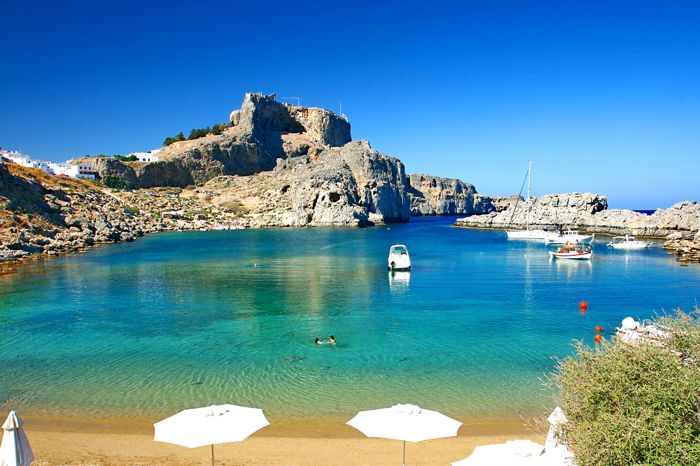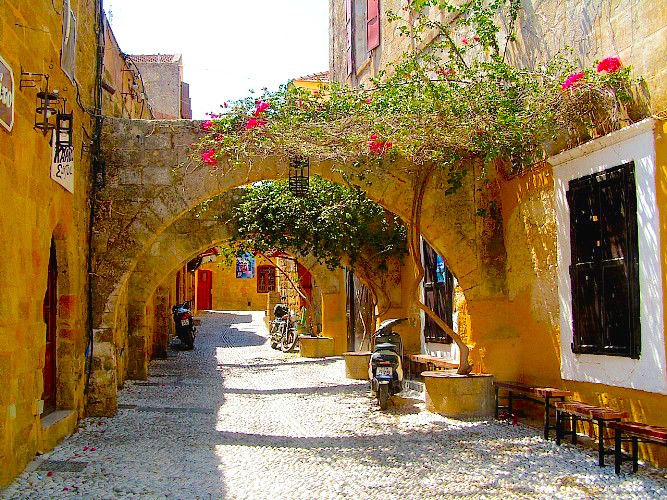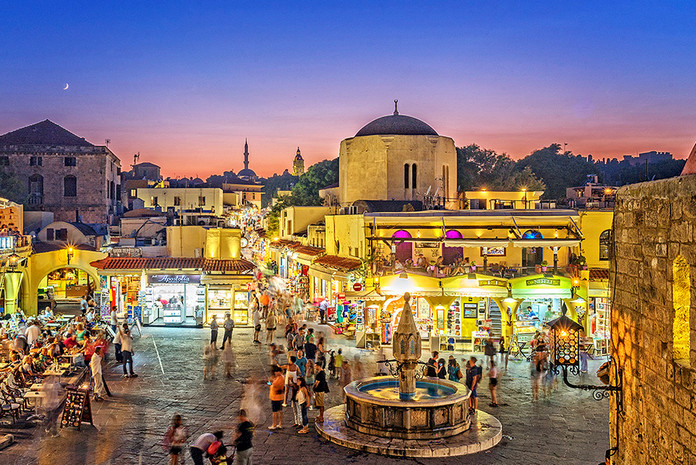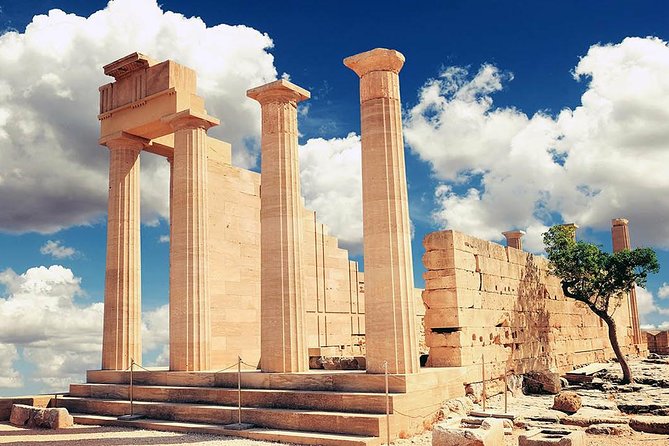The Dodecanese lie east to the Cyclades. They are the final remains of the bridge between the Peloponnese and Asia Minor. The Dodecanese have been inhabited since the prehistoric period and were ruled by the Minoans and then the Achaeans.

Their Economic and intellectual development slowly began with the arrival of the Dorians in 1100 BC. This development was cut off prematurely by the Persian tempest which then shook all Greece. After the defeat of the Persians, the Dodecanese became members of the Athenian Alliance in408 BC and the three large towns of Rhodes united into one state.
More particularly, Kos prospered in the 4th and the 3rd century BC because of the School of Medicine founded there by Hippocrates. The Romans occupied the islands in 146 BC to be followed by the long period till the time of the Crusades. In 1309 KNights of the Order of Saint John became the rulers of Rhodes and then extended their sovereignty to the other islands as well. IN 1522 the islands were occupied by the Turks and in 1912 by the Italians.
The Dodecanese were united with Greece in 1948. At the crossroads of the continents, the Dodecanese are a powerful pole of attraction for visitors who come to them to enjoy the healthy climate, the sun, and the sparkling clean sea.
 The ferries from Piraeus usually arrive at Rhodes at sunrise. At that time of the day, the sun which gilds the sea also gilds the two statues- the deer and the fawn- which stand on the columns at the entrance of the ancient harbor and which have become the symbol of the island. Tradition says that their position was once occupied by the famous Colossus, one of the 7 wonders of the world.
The ferries from Piraeus usually arrive at Rhodes at sunrise. At that time of the day, the sun which gilds the sea also gilds the two statues- the deer and the fawn- which stand on the columns at the entrance of the ancient harbor and which have become the symbol of the island. Tradition says that their position was once occupied by the famous Colossus, one of the 7 wonders of the world.
This was an enormous bronze statue representing the god Helios holding a burned torch. One foot stood on one side of the entrance to the harbor and the other foot on the other so that ships passed beneath him. The search for the statue which was thrown down by a major earthquake continues but unfortunately in vain since the statue was cut into pieces and sold as bronze to the Saracens.
Opposite the statue of the deer and a little above the old harbor stands the Castello: the Palace of the Grand Master of the Knights of Rhodes. Nest to it is the medieval town, scarcely affected by the passage of time. The new city with its modern buildings and large hotels extends mainly to the north-west, the point where the boundless beaches start and continue for kilometers.

Rhodes, the biggest of the Dodecanese and the fourth largest in Greece, lies in the southeast of the Aegean, very close to the coast of Asia Minor.
Its mountains are mostly pine-covered with well-watered and fertile valleys between them. The most important products of Rhodes are wine and olive oil but it also produces folk artifacts such as ceramics, embroidery, textile, and carpets.
Rhodes, the pearl of the Mediterranean, as it has been called, is of the greatest interest both for its natural beauty and for its archaeological treasures. For that reason, it was proclaimed a world cultural site by UNESCO.
With its marvelous climate and its well-organized tourist infrastructure, it is a place for holidays all year round.
How to get there:
Rhodes can be reached by direct flights from many of the European capitals as well as from Athens, Thessaloniki, Crete, Mykonos, Paros, Santorini, Kos, Karpathos, Kassos, Kastelorizo, and Mytilene.
There are ferries to Rhodes from Piraeus, Rafina and the Dodecanese, the Cyclades, the islands of the northern and eastern Aegean, Kavala, and Cyprus.

Top attractions:
1. Palace of the Grand Masters
A massive structure with towers and mosaic floors. The fortress has about 150 rooms. The citadel was built by the Knights of St.John who ruled the island from 1309 to 1522.
2. Archaeological Museum
During the times of the Knights of St.John, the museum served as a hospital. Now it’s rooms are filled with marble sculptures found all over the island.
3. Street of the Knights
This is where the knights had their inns. The order was divided into 7 “Tongues” (England, France, Germany, Italy, Aragon, Provence, Auvergne) each with their own inn where the members would wine and dine.
4. Suleyman Mosque
When the Ottomans took over the island, this mosque was built to commemorate the conquest of the island. During the reign of Sultan Suleyman, who was one of the most powerful rulers of that time, lots of island churches were converted into mosques.
5. Reloy Clock Tower
The clock was built in the 7th century and has gone through several reconstructions since then. Climb the tower for a panoramic view of the old town.
6. Elli Beach
This is the town’s most popular beach and in the summer months, it gets very crowded. The beach is mostly pebbly.
7. Mandraki Harbour
It’s one of the 3 harbors on the island and it is believed that once the Colossus of Rhodes stood here. Nowadays you will find the sculptures of the deer and the fawn- the symbols of the island and windmills.
8. The Acropolis of Lindos
It’s an interesting site as you have to climb a steep path to get to the top. You will be rewarded with a panoramic view of Lindo’s. The fortress was used as a fortress during Ottoman and Hellenic times. You will also find 20 Hellenistic columns and remains of the temple of Athena Lindia.